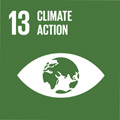- Docente: Alessandro Amorosi
- Credits: 6
- SSD: GEO/02
- Language: English
- Moduli: Alessandro Amorosi (Modulo 1) William Cavazza (Modulo 2)
- Teaching Mode: In-person learning (entirely or partially) (Modulo 1); In-person learning (entirely or partially) (Modulo 2)
- Campus: Bologna
- Corso: Second cycle degree programme (LM) in Science of Climate (cod. 5895)
Learning outcomes
At the end of the course the student is able to evaluate the scientific basis of Earth’s past climate system, identify past states of the climate system that offer the closest analogs to the climates of the coming decades, and appreciate the scientific context for the long view on a warming world, based on the recognition of natural, past climate variability rather than mathematical models of future potential scenarios. Module I focuses on pre-Quaternary examples of global climate changes, including quantitative methods for the study of past global changes, examples of rapid climate changes in the geological past, and the relationships between geodynamics, paleogeography and climate. Module II focuses on climate variability during the Quaternary (glacial and post-glacial), with emphasis on the high-resolution signature of climate change in the stratigraphic record on millennial to centennial timescales, from quantitative dating methods to climate proxies.
Course contents
Module I – Quaternary climate change
Timescales of climate change, orbital-scale climate change, the Milanković theory, glacial-interglacial cycles, sub-Milanković events, millennial to centennial-scale climate fluctuations, climate change in the geological record using ice cores, marine sediment cores, speleothems, pollen and other records: the Last Interglacial, the Last Glacial Maximum, climate during the last deglaciation, the Younger Dryas, the Holocene, the Last Millennium and the Anthropocene.
Module II – Pre-Quaternary climate change
Plate-tectonics and long-term climate patterns. Pre-Quaternary glaciations and pole positions. Plate-tectonics and the CO2 cycle. Greenhouse climates in the geological past. Past sea-level variations: causes and climatic effects. Global cooling since 50 million years ago. Paleo-oceanographic changes and their effects on climate change. Continental collisions, orogeny, weathering and climate change. Future climate change at tectonic time scales.
Readings/Bibliography
William F. Ruddiman, "Earth's Climate - Past and Future", Third Edition, 2014. W.H. Freeman and Company - New York, 445 p.
Teaching methods
Lectures, Powerpoint presentations, invited seminars
Assessment methods
Final written exam
Teaching tools
Video projectors, databases, computer software
Office hours
See the website of Alessandro Amorosi
See the website of William Cavazza
SDGs

This teaching activity contributes to the achievement of the Sustainable Development Goals of the UN 2030 Agenda.
